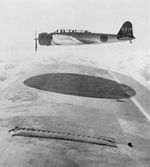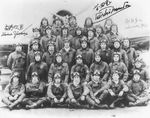B5N
| Country | Japan |
| Manufacturer | Nakajima Aircraft Company |
| Primary Role | Torpedo Bomber |
| Maiden Flight | 1 January 1937 |
Contributor: C. Peter Chen
ww2dbaseManufactured by Nakajima, the B5N Navy Type 97 Carrier Attack Bombers were the Japanese Navy's standard torpedo bombers at the start of the Pacific War. They were designed by Katsuji Nakamura in response to a 1935 Navy specification, and first took flight in Jan 1937 with a contract from the Japanese Navy very soon after that. They were manned by a crew of three: one pilot, one navigator/bombardier/observer, and one radio operator/gunner. They first saw combat in the Second Sino-Japanese War where combat experience on the Chinese coast revealed the design's weakness with crew protection. Reluctant to add armor, which would add weight to the aircraft, Nakajima decided on a modified design in 1939 with slightly better performance so that the pilots would have better odds at evading hostile interceptors. In Dec 1941, B5N torpedo bombers played a key role in the attack on Pearl Harbor at the start of the Pacific War. American pilots soon found these "Kate" bombers significantly faster and more capable than the Devastator torpedo bombers they they used. As the war went on, B5N torpedo bombers also played parts in the sinking of American carriers Yorktown, Lexington, and Hornet. Although obsolete within the first two years of the Pacific War, they remained in service until the end, serving in training, anti-submarine, or homeland defense roles. By the end of the war, 1,150 were built.
ww2dbaseSource: Wikipedia.
Last Major Revision: Mar 2007
B5N Timeline
| 29 Apr 1945 | [incorrectly given as 27 Apr 1945 by some sources] Acting on a reconnaissance report stating two US aircraft carriers were in Seeadler Harbor, Manus, Admiralty Islands, the Japanese executed an aerial torpedo attack consisting of two (some sources 3) Nakajima B5N2 “Kate” bombers. The targets were actually floating drydocks USS ABSD-2 and ABSD-4 and each was struck with one torpedo, causing minimal damage to the docks. USS ABSD-4 had three ships in dock at the time, including a seaplane tender that was docked for emergency repairs and thus had not offloaded her ammunition. None of the ships in dock were damaged in the attack and all were returned to service. |
SPECIFICATIONS
B5N2
| Machinery | One Nakajima Sakae 11 radial engine rated at 1,000hp |
| Armament | 1x7.7mm Type 92 machine gun, 1x800kg Type 91 torpedo or 3x250kg bombs or 6x60kg bombs |
| Crew | 3 |
| Span | 15.52 m |
| Length | 10.30 m |
| Height | 3.70 m |
| Wing Area | 37.70 m² |
| Weight, Empty | 2,279 kg |
| Weight, Loaded | 3,800 kg |
| Weight, Maximum | 4,100 kg |
| Speed, Maximum | 367 km/h |
| Rate of Climb | 6.50 m/s |
| Service Ceiling | 8,260 m |
| Range, Normal | 1,935 km |
Photographs
 |  |
Please consider supporting us on Patreon. Even $1 per month will go a long way! Thank you. Please help us spread the word: Stay updated with WW2DB: |
Visitor Submitted Comments
22 Mar 2009 02:42:37 PM
Above photo of Nakajima B5N2 Torpedo Bomber T.A.I.C. # 6 Repainted in simulated Japanese Navy camouflage and markings,for recognition photographs undergoing flight testing. The Kate was captured on Saipan, in June 1944. Technical Air Intelligence Unit, Anacostia Naval Air Station, Washington D.C.
29 Mar 2009 10:42:02 AM
The last Japanese aircraft shot down at 05:40 hrs. was a Nakajima C6N1 Saiun (Myrt). The last confirmed victory of WWII. Five minutes later the war was over, and all Japanese aircraft were grounded.
23 Apr 2010 08:20:00 PM
The Kate continued to be built until 1943.
Total production was 1,100 However, by 1944/
1945, like most other Japanese aircraft, the
Kate was converted to kamikaze operations.
The Kate had a crew of three:
Pilot
Navigator/bombardier/observer
Radio operator/gunner
Armament:
1x800kg (1,760lb) type 91 torpedo or
3x250kg (550lb) bombs or
6x60kg (132lb) bombs
1x7.7mm machine gun (lewis type) hand held,
drum fed magazine w/97 rounds operated by
the rear gunner.
28 Jul 2011 08:40:47 AM
Followup information about the Kate captured on Saipan. Continued from comment dated Mar,
2009.
After capture on Saipan in June 1944 the B5N Kate KEB-306 was found abandoned at Aslito airfield.
The Kate was equipped with H-6 radar, and was assigned to the 931st Kokutai. The unit was formed at Saeki Air Base, Japan, in February 1944. The Kate was made airworthy
and evaluated by Technical Air Intelligence,
Anacostia Naval Air Station.
This aircraft could have been scrapped at the end of WWII
11 Jan 2012 10:56:54 AM
CODE NAME "KATE"
In 1935 the Imperial Navy requested a new carrier attack bomber, to replace the older Yokosuka B4Y, Biplane bomber both Mitsubishi and Nakajima sent designs, Nakajima won the competition and started work on the new bomber.
The B5N1 was a modern design all metal, low wing monoplane, with wide-track retractable landing gear, folding wings, fabric covered control surfaces, enclosed greehouse canopy for the three man crew.
The B5N1 entered service in 1937 and was sent to China supporting the Army bombing
Chinese positions. Aircraft at this time, were painted silver overall w/red tails later
camouflage was introduced and aircraft were painted dark green and brown.
The new model, B5N2 replaced the older B5N1s in 1939, and were sent to training schools used as target tugs, glider tugs and sent to second line units for operational training.
All visitor submitted comments are opinions of those making the submissions and do not reflect views of WW2DB.

» Attack on Pearl Harbor
» Solomon Islands Campaign
Related Document:
» Carrier Aircraft Specifications
- » 1,176 biographies
- » 337 events
- » 44,933 timeline entries
- » 1,245 ships
- » 350 aircraft models
- » 207 vehicle models
- » 376 weapon models
- » 123 historical documents
- » 261 facilities
- » 470 book reviews
- » 28,470 photos
- » 365 maps
Winston Churchill, 1935
22 Mar 2009 02:40:57 PM
Above photo of Nakajima B5N2 Torpedo Bomber T.A.I.C. # 6 Repainted in simulated Japanese Navy camouflage and markings,for recognition photographs undergoing flight testing. The Kate was captured on Saipan, in June 1944. Technical Air Intelligence Unit, Anacostia Naval Air Station, Washington D.C.